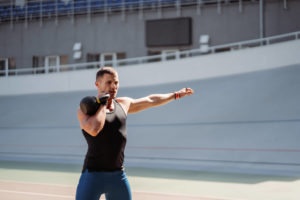
The pros and cons of this popular resistance training devices
By Strength Sensei CP
Publication Date: 2009
Kettlebells were once something you would only see in old-time physical culture magazines, often with men wearing leotards and sporting handlebar mustaches swinging them around. A bit odd and certainly amusing, but can kettlebells be a serious piece of exercise equipment to consider adding to your weight training toolbox?
So that we’re on the same page, let’s define what a kettlebell is and where it came from. A kettlebell is a single round weight with a U-shaped handle attached to it. The bottom of most modern kettlebells has a flat surface so they can stand upright and are easily stored. The traditional handles are relatively thick, necessary to secure the weight, and do not have revolving sleeves. Some modern kettlebells (usually the lighter ones) have thinner handles for easier gripping, and there are some expensive units that have revolving sleeves.
The Russian word for kettlebell is Girya and the weights are called poods. It appears that we can trace its history back to at least 1704, when it was described in a Russian dictionary as a counterweight used in markets. Eventually, kettlebells became repurposed as fitness tools and even a sport. The first major competition took place in Moscow 1948 in the USSR. It consisted of two events, the one-arm power snatch and the clean and jerk. The lifts were performed for repetitions.
As a strength and conditioning method, throwers in track and field used them not so much as a tool to build basic strength but for throwing. Because the grip is positioned so far from the weight, kettlebells enable you to perform release movements easily. If you’re interested in what the best throwers were doing, check out the writings of Anatoliy Bondarchuk.
Bondarchuk won the 1972 Olympics in the hammer and trained Yuriy Sedykh, a Russian hammer thrower who won gold in 1976 and 1980. And as a bit of trivia, the great Russian weightlifting champion Vasily Alexeev, the first man to clean and jerk 500 pounds, used kettlebells. Perhaps this explains why when he injured his hand just before a major invitational competition, he had the skill to put on an exhibition and perform a one-arm snatch of 231 pounds!

There should be no question that kettlebell training can improve physical fitness, perhaps better than bodyweight-only exercises. A study published in 1983 had two groups of subjects perform four general tests of physical fitness: pull-ups, standing broad jump, 100- meter sprint, and a 1k (.6 mile) run. One group performed a physical fitness program that included practicing these tests; the other group only did kettlebell exercises. Despite never practicing the test, the kettlebell group achieved the best results in post-testing. So yes, kettlebells can be used to improve physical fitness.
With few exceptions, such as the release drills with throwers, pretty much any exercise you can perform with a kettlebell, you can perform with a dumbbell. One popular exercise performed with kettlebells is the goblet squat, which I find to be especially moronic. I say this because the amount of weight you use is limited by the strength in your deltoids, rhomboids, and elbow flexors. There is no way a goblet squat can overload your legs. Also, some exercises that can easily be performed with dumbbells, such as incline presses, can be awkward to perform with kettlebells.
OK, but what about kettlebell swings? I’m not a fan. I believe they can be harmful to the disks if they are not performed properly. One issue is that as momentum builds up, you might stretch further than you could otherwise. It’s not that performing the exercise will immediately cause an injury. It’s like a cavity in that the effects progressively worsen over time and make you a regular patient of a chiropractor.
I always use your analogy of if you go to something different, it has to be an improvement or it has to be more fun. The dumbbell, in fact, was designed as an improvement over the kettlebell! If you’ve read my articles since the late 80s, you will not find any workouts using kettlebells. Why? Few gyms have complete sets of kettlebells, and they were quite expensive.
For the gyms I helped design, I recommended that gym owners invest in a complete set of high-quality dumbbells, preferably those with revolving sleeves and thick handles. I would rather have a full set of dumbbells in small increments than a half set of dumbbells and a half set of kettlebells in large increments. The small increments are important, especially when working the smaller/weaker muscle groups.
Whereas performing certain rotator cuff exercises with a 10-pound dumbbell may be too light, a 20-pound one will probably be too heavy. This may seem extreme, but consider that when NHL hockey player Jim McKenzie started with me in 1998, he could only use 8 pounds for 3 reps on the single-arm external rotation exercise; four months later, he did 35 pounds for 8 reps.
The strength and conditioning community is always looking for the next best thing. Although kettlebells offer a unique way to add resistance to perform many popular exercises, I prefer dumbbells.
